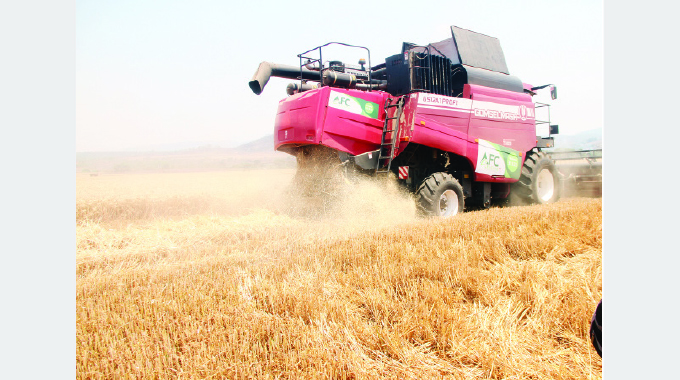326 000 tonnes of wheat harvested so far

Precious Manomano
Herald Reporter
Wheat harvesting is almost complete and so far 92 percent has been harvested, with more than 326 000 tonnes already in storage.
This comes as wheat farmers and other stakeholders are working hard to have harvesting completed so that they can concentrate on planting their summer crops, while at the same time saving the cereal from rain damage.
A weekly report from Agricultural and Rural Development Advisory Services indicated that the cumulative area harvested across the provinces stands at 72 663ha, which is 92 percent of the planted area with a cumulative production of 326 166 tonnes.
So far over 3 980 hectares were affected by the rains countrywide.
Recently, Lands, Agriculture, Fisheries, Water and Rural Development Deputy Minister Vangelis Haritatos warned farmers to fast track wheat harvesting amid the onset of the rainy season which may affect the quality of the crop.
Zimbabwe Indigenous Women Farmers Association Trust president Mrs Depinah Nkomo said there was a possibility that the remaining crop in the fields could be compromised by the rains.
“The progress showed by farmers so far on harvesting is a positive move, but the challenge is the remaining percentage which is currently in the fields,” she said. “This may be a challenge because the rains obviously may destroy the wheat. By this time farmers should have completed harvesting.”
Zimbabwe Commercial Farmers’ Union president Dr Shadreck Makombe said wheat was badly destroyed by veld fires and rains, adding that next year farmers should learn to plant their crop early to avoid rain disasters.
“Next year, farmers should plant early even to start in April because the crop which was compromised was the late crop which was planted in June,” he said. “Moreover farmers should study their area. For example farmers in Marondera, Gweru, Hwedza and other areas which are not very hot should start planting early.
“Veld fires and rains were the major disasters which affected the wheat output but next year farmers should make sure that next year we improve on time management.”
Zimbabwe National Farmers’ Union (ZNFU) vice president Mr Fidelis Gweshe said almost 40 000 tonnes were at the dryers to reduce moisture content so that they are delivered to Grain Marketing Board (GMB).
“At the moment some of the wheat is at the dryers to allow removal of the moisture so that it is distributed to GMB,” he said.
Global wheat markets have been affected by the conflict in Ukraine, since that country was a major exporter and Russia, another major exporter, used Black Sea ports in Russia and Ukraine for most of its exports.
More than 85 000 hectares were put under wheat during the 2022 winter season compared to 66 000 hectares last year and this is expected to produce self-sufficiency with a small surplus for the first time since wheat farming started in Zimbabwe in 1966.
The projected harvest is around 380 000 tonnes against a national annual requirement of about 360 000 tonnes.
This gives the country a surplus of about 20 000 tonnes. The Second Republic has been working hard to push agricultural output and farm incomes by going for self-sufficiency of most food products, since this gives the farmers guaranteed markets and ensures Zimbabwe can cope with any geo-political or global supply challenges.
Last season, farmers produced wheat that was enough to cover nine months’ supply to meet domestic demand with GMB receiving 156 144 tonnes from the farmers it had under contract.







Comments